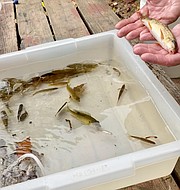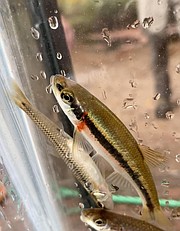The genus of Lepomis includes several species of Sunfish; fish held here in special narrow tank for identification then released. Photo by Susan Laume/The Connection
Big Rocky Run, at Eleanor Lawrence Park in Chantilly, was the stage for a recent demonstration of stream monitoring and fish identification for Virginia Master Naturalist trainees during a day of field study. The demonstration was conducted by Fairfax County’s Stormwater Planning Division, which regularly monitors the species of fish in area streams as a direct measure of stream health.
The naturalists’ field trip, on Oct. 24, followed an earlier lecture on ichthyology (the study of fishes) by Fairfax County Ecologist Chris Ruck. During the field trip, Ruck, and members of his Stormwater Planning team, used a specially designed electro-fisher unit, which temporarily stuns fish within a limited range charge-line between two portions of the equipment. Air in the fish bladders causes them to rise to the surface where they can be netted for study, then released.
Fairfax County includes more than 800 miles of streams. Monitoring assesses their water and natural habitat quality and gives a picture of the overall health of our waterways. It also is required by state and federal regulations. Our County is part of the watershed for the Chesapeake Bay, a water body protected by environmental regulations.
These efforts are not related to our drinking water, since stormwater is not treated and runs through a separate drainage system. Rating following a 2019 sampling found 88 percent of county streams were rated in fair to poor condition. According to the Public Works and Environmental Department, this means our streams are impaired and lack biodiversity.
The portion of Big Rocky Run through the park is considered to be in better condition than many other streams. On this occasion, the team netted 16 of the 210 species of fish common to Virginia waters. Fairfax County is home to 14 of the 24 fish families, found in the Commonwealth, which includes for example, eels, minnows, perches, suckers, and sunfish.
“Virginia Master Naturalists” is an all-volunteer organization which provides education, outreach, and service for the beneficial management of natural resources and natural areas in the Commonwealth. The organization, its training program and projects are jointly sponsored by the following state agencies and departments: Virginia Cooperative Extension; Game and Inland Fisheries; Forestry; Conservation and Recreation; Museum of Natural History; Environmental Quality.
For more information on stream monitoring or the Virginia Master Naturalists Program, readers are directed to these sites: https://www.fairfaxcounty.gov/publicworks/stormwater; http://www.vmnfairfax.org/SitePages/Home.aspx.



